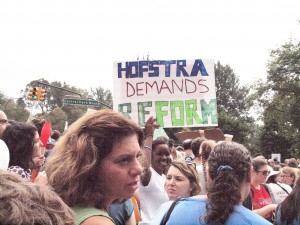By Elyse CarmosinoSPECIAL TO THE CHRONICLE
This past Sunday, in major cities around the word, people of all ages, nationalities and races gathered in staggering numbers to urge policymakers to take action to prevent climate change. More than 50 Hofstra students participated along with millions of others across the globe.
The New York City Climate March, also known as the People’s Climate March or the Great March for Climate Action had 310,000 people registered. Even more unregistered people marched, waving signs and chanting from the sidewalks, some even jumping over barriers, separating marchers from spectators to join in the colorful parade of thousands.
Among the University, some of the clubs represented at the protest were Get Global, Students for a Greener Hofstra and students from the geology and global studies departments. Dedicated professors led students from several classes, including global studies and geography, biology, sociology and political science.
One marcher was cultural globalization professor Kari Jensen.
“Overall I think the march was a success and a great experience for the people involved… My impression was that we all had a really good time,” Jensen said. “To me, it meant a lot to see all the engaged people of all ages coming together in a demonstration to show politicians and country representatives in the [United Nations] that we care deeply about action.”
Professor Jensen was not the only one who thought the march was a success. Sophomore CJ Burka, who attended the march with her club Get Global agreed.
“I think that we accomplished what we came to do: to make it known that we won’t tolerate the abuse of power from those who are slowly destroying our planet without the consent of the everyday population,” Burka said.
She also said her favorite part of the day was the two minutes of silence held at noon.
“It’s never easy to get a group of any size to be quiet quickly. But in those two minutes you could hear a pin drop, which is never something I could say about New York City,” Burka said. “When the moment was over, the roar of the entire crowd made it seem like we were really making our voice, as the people, heard. The contrast in sound is something I’ll never forget just because I could feel the passion and dedication that everyone had for the cause.”
It will not be known just how successful the march was until the results of the United Nations Summit Meeting, held by UN Secretary General Ban Ki-moon on Monday, Sept. 22 are publicized. World leaders met to discuss what should be done about the climate change issue.
Despite the fact that the march was to protest climate change, participants showed that the subject had a wide array of different meanings. Different organizations clustered together holding signs that promoted causes from saving the ocean to encouraging people to eat organic. Some protested fracking while others held signs suggesting the use of solar power. There were posters that called out for fair wages for workers and others encouraging to, “Think of the Children.”
Some marchers dressed in costumes and others played instruments. Temperance Staples, also a sophomore marching with Get Global, summed up what many marchers seemed to be in agreement on.
“[It was] just the magnitude of the whole thing,” Staples said. “You look around and there’re millions of people who have an issue and that issue is a lot less shallow than [some might think]. There are workers at stake, there are jobs at stake, there’s the economy at stake, there’s the planet at stake, everything’s at stake. Everything ties in to this. You don’t have to be Republican, you don’t have to be Liberal, you don’t have to be black [and] you don’t have to be white, somehow you are tied in to this one massive issue and everything is connected and everything is globalized.”
Staples was not alone in her feelings. “…It’s not going to be any easy fight, but what fight ever was?” Burka said.








